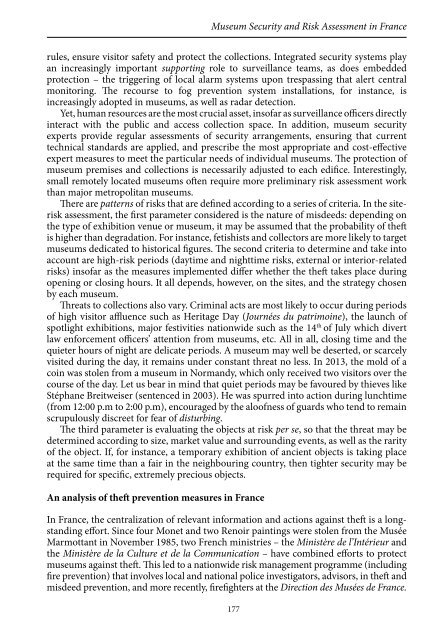Countering
Book_observatory_illicit_traffic_version%20issuu
Book_observatory_illicit_traffic_version%20issuu
You also want an ePaper? Increase the reach of your titles
YUMPU automatically turns print PDFs into web optimized ePapers that Google loves.
Guy Tubiana<br />
Today, a central network monitored by the Ministère de l’Intérieur was implemented<br />
in 2007. If security is breached in a partner museum, it alerts law enforcement forces in<br />
real time. The measures implemented in case of theft differ whether the theft takes place<br />
during opening or closing hours. Conversely, they depend mainly on the sites, and the<br />
strategy chosen by each museum. In addition, the scope of any theft prevention mission<br />
supersedes the sole protection of museums now encompassing other places of interest,<br />
such as religious and historic monuments, archives and archeological sites. The expertise<br />
of law enforcement officers lies in an acute knowledge of the modus operandi of thieving<br />
minds, reinforced by first-hand experience in prevention and apprehension.<br />
While a security adviser will focus on the most efficient technological equipments,<br />
a law enforcement officer is most likely to actively discourage criminal intention. They<br />
are familiar with the way a criminal mind works, and can anticipate flaws in security<br />
and protection or possible escape routes. And so, preventive measures against theft<br />
(routine perimeter checks, object surveillance, etc.) are to be undertaken to gauge the<br />
threat levels by potential aggressors, determine the threat environment and the best<br />
protective measures so as to establish an action plan for efficient response. The measures<br />
implemented in case of theft differ whether it takes place during the opening or the<br />
closing hours. But it mainly depends on the sites, and the strategy chosen by each<br />
museum.<br />
Routine perimeter checks and object surveillance altogether are thus among the<br />
necessary steps for risk preparedness to ensure viable protection. In recent years, law<br />
enforcement officers have been trained to offer an immediate and appropriate response to<br />
a theft. There are now two police officers in charge of prevention in all French museums,<br />
whether national and unlabelled museums or private venues. The team may be required<br />
to protect a high-profile exhibition offsite, assess security provision at host venues – a<br />
town hall or company office – and improve protection, if required.<br />
Conclusion<br />
In 2010, the Ministère de la Culture et de la Communication issued an information<br />
guide on the security of cultural objects for public and private owners. Concerning the<br />
fight against illicit trafficking, it is stated therein that the following measures are to be<br />
implemented simultaneously: i) reinforce theft prevention, ii) raise awareness in public<br />
and private owners of cultural goods, iii) create and provide appropriate documentation<br />
(guidelines, tools, reports) and iv) improve communication between collaborators<br />
involved.<br />
Efforts to attain these objectives must be maintained, for museum collections are<br />
constantly in jeopardy. Yet constant efforts to improve their protection are to be observed<br />
in France, especially in recent years. The museum security expert intervenes to shed light<br />
on the existing, or potential security vulnerabilities into buildings which may be designbased,<br />
or concern access and adjacency as well as logistic requirements. Thus, capacity<br />
building in museum security, close collaboration between security experts and museum<br />
professionals must come foremost, and dialogue at a local, national and international<br />
level is essential.<br />
178


